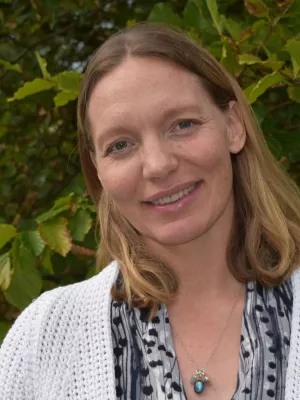
Marianne Hall
Research coordinator

Spring photosynthetic recovery of boreal Norway spruce under conditions of elevated [CO2] and air temperature
Author
Summary, in English
Accumulated carbon uptake, apparent quantum yield (AQY) and light-saturated net CO2 assimilation (A(sat)) were used to assess the responses of photosynthesis to environmental conditions during spring for three consecutive years. Whole-tree chambers were used to expose 40-year-old field-grown Norway spruce trees in northern Sweden to an elevated atmospheric CO2 concentration, [CO2], of 700 mu mol CO2 mol(-1) (C-E) and an air temperature (T) between 2.8 and 5.6 degrees C above ambient T (T-E), during summer and winter. Net shoot CO2 exchange (A(net)) was measured continuously on 1-year-old shoots and was used to calculate the accumulated carbon uptake and daily A(sat) and AQY. The accumulated carbon uptake, from 1 March to 30 June, was stimulated by 33, 44 and 61% when trees were exposed to C-E, T-E, and C-E and T-E combined, respectively. Air temperature strongly influenced the timing and extent of photosynthetic recovery expressed as AQY and A(sat) during the spring. Under elevated T (T-E), the recovery of AQY and A(sat) commenced similar to 10 days earlier and the activity of these parameters was significantly higher throughout the recovery period. In the absence of frost events, the photosynthetic recovery period was less than a week. However, frost events during spring slowed recovery so that full recovery could take up to 60 days to complete. Elevated [CO2] stimulated AQY and A(sat) on average by similar to 10 and similar to 50%, respectively, throughout the recovery period, but had minimal or no effect on the onset and length of the photosynthetic recovery period during the spring. However, AQY, A(sat) and A(net) all recovered at significantly higher T (average +2.2 degrees C) in T-E than in T-A, possibly caused by acclimation or by shorter days and lower light levels during the early part of the recovery in T-E compared with T-A. The results suggest that predicted future climate changes will cause prominent stimulation of photosynthetic CO2 uptake in boreal Norway spruce forest during spring, mainly caused by elevated T, but also elevated [CO2]. However, the effects of elevated T may not be linearly extrapolated to future warmer climates.
Department/s
- Centre for Environmental and Climate Science (CEC)
- BECC: Biodiversity and Ecosystem services in a Changing Climate
- MERGE: ModElling the Regional and Global Earth system
Publishing year
2013
Language
English
Pages
1177-1191
Publication/Series
Tree Physiology
Volume
33
Issue
11
Document type
Journal article
Publisher
Oxford University Press
Topic
- Earth and Related Environmental Sciences
Keywords
- apparent quantum yield
- boreal forest
- carbon dioxide
- climate change
- light-saturated photosynthesis
- Picea abies
- whole-tree chambers
Status
Published
ISBN/ISSN/Other
- ISSN: 1758-4469